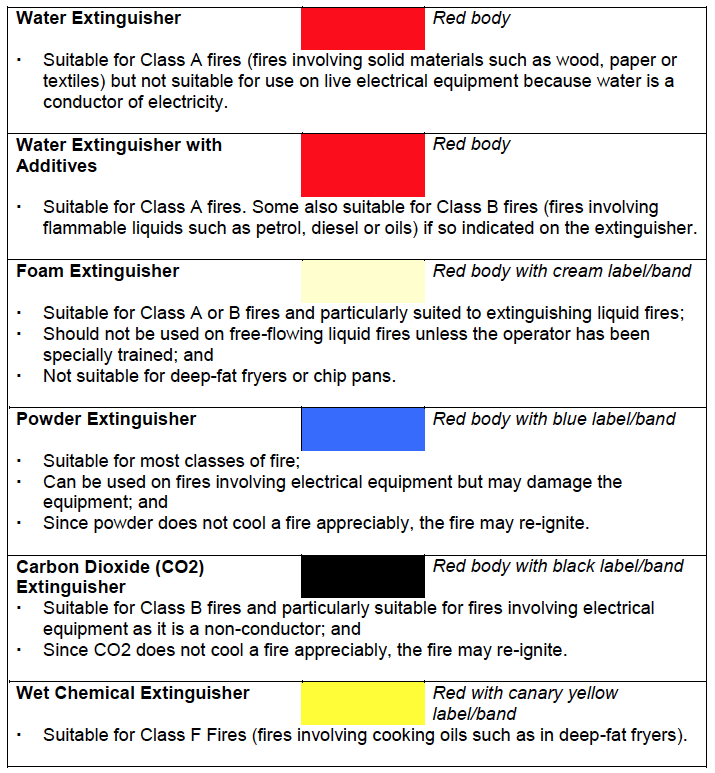Practical fire safety guidance for existing non-residential premises
Guidance note on fire safety responsibilities for business owners of non-residential premises.
Chapter 9: Means For Fighting Fire
344. A small fire tackled with fire-fighting equipment in the early stages may be prevented from developing into a fire of life-threatening proportions. Fire-fighting equipment can fall into one of two categories; either (a) it is designed for use by persons, such as portable fire extinguishers or (b) it is a fixed installation, such as a sprinkler system, which comes into operation automatically in the event of fire.
Automatic Life Safety Fire Suppression
345. An automatic life safety fire suppression system operates automatically on detection of an outbreak of fire within the building. In the case of a conventional sprinkler system, water is discharged from the individual head which has detected heat from the fire; all other discharge heads remain closed unless similarly affected by heat. An automatic life safety fire suppression system can be effective in controlling a fire and limiting fire growth.
346. Part 3 of the 2005 Act covers life safety. Some suppression systems will have been provided to protect property. Some schools have sprinkler systems installed for the protection of property and assets as opposed to life safety.
347. Where buildings are fitted with a smoke and heat exhaust ventilation system, sprinklers are usually installed to restrict fire size. Sprinklers may also have been fitted where there is a large compartment size.
348. Fire suppression should be appropriate to the occupancy and should be determined on the basis of risk. Design and installation rules for automatic life safety sprinkler system are contained in BS EN 12845 or LPC Rules. Water mist systems are bespoke systems designed on the basis of established test performance. Many suppression systems are third party certificated which helps to assure their quality.
349. Other suppression systems may be used for high hazard industrial situations such as foam installations and gas flooding systems (total flooding or local application). Information on the systems available is contained in BS 5306: Part 0.
350. In storage areas, there should be appropriate clearance between the storage and sprinkler heads so that there is no interference with sprinkler water distribution.
Fire-Fighting Equipment For Use By Persons
351. Portable fire-fighting equipment may be provided for use by persons. There are third party certification schemes for fire-fighting equipment; this can give some assurance of quality.
352. The number of fire extinguishers provided will depend on the circumstances within and the size of individual premises. Portable extinguishers should be simple to operate, readily accessible, within the handling capabilities of staff and be suitable for the classes of fire anticipated (see Table 8). Extinguishers are described by extinguishing capacity. They are marked with a letter and a number: the letter denotes the class of fire, the number denotes the fire size extinguishing capability. An extinguisher could for example have a rating such as '13A' or '55B'.
353. Information on the selection and installation of fire extinguishers is contained in BS 5306: Part 8. A guide to the level of provision of class A extinguishers is obtained by multiplying the floor area of a storey by 0.065. For example, a floor area of 400 m 2 would have a rating of 26A (400 x 0.065 = 26) which is the total value of class A extinguishers and can be achieved by combinations of extinguishers with different ratings to achieve the total value. Where there are other classes of fire, appropriate extinguishers for these may be necessary. In small premises, having one or two portable fire extinguishers of an appropriate type and readily available for use may be all that is necessary.
354. Fire extinguishers are positioned on escape routes, close to room or storey exits, final exits from the building or, if necessary, adjacent to hazards. They may be placed on a stand or hung on a wall at a convenient height so that they can be easily lifted off. Generally no one should have to travel more than 30 m to reach a fire extinguisher. It is good practice to group extinguishers together in fire points at a similar position on each floor.
355. Where there is high potential for malicious operation, consideration may be given to siting extinguishers in areas under staff control.
356. While permanent hose reels can provide an effective fire-fighting facility when used by trained personnel, there are disadvantages. When deployed, a hose reel may prevent doors from fully closing causing the spread of smoke, and the hose may pose an obstacle to the escape of occupants.
357. A fire blanket may be appropriate. It may be used to smother a small fire involving cooking oil or fat. Where a kitchen provides meals on a scale larger than a normal domestic household, a heavy duty fire blanket may be appropriate.
Table 8 - Extinguisher types

Contact
Email: Fire and Rescue Unit: FireDivision@gov.scot
Phone: 0300 244 4000 – Central Enquiry Unit
The Scottish Government
St Andrew's House
Regent Road
Edinburgh
EH1 3DG
There is a problem
Thanks for your feedback